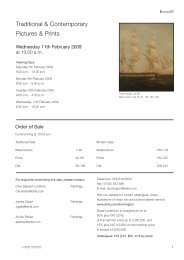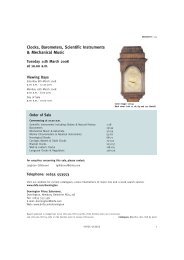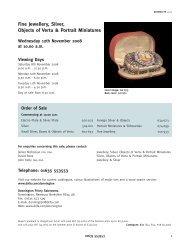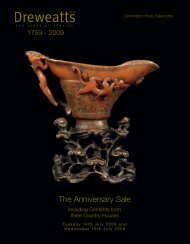Donnington Priory Salerooms
Donnington Priory Salerooms
Donnington Priory Salerooms
You also want an ePaper? Increase the reach of your titles
YUMPU automatically turns print PDFs into web optimized ePapers that Google loves.
104<br />
A fine Queen Anne ebonised eight-day longcase clock<br />
John Knibb, Oxford, early 18th century<br />
The fully-latched five finned-pillar inside countwheel bell-striking movement<br />
with separate shaped-cock for the pallet arbor and backplate cut for the<br />
pallets, long crutch and 11.75 inch square gilt brass dial with delicate border<br />
engraved calendar aperture, silvered subsidiary seconds ring and blued-steel<br />
hands to the finely matted centre within an applied silvered Roman numeral<br />
chapter ring with stylised fleur-de-lys half hour markers, Arabic five minutes<br />
and signed John Knibb, Oxon to lower edge, the angles applied with gilt twin<br />
cherub and crown pattern spandrels, the case with Knibb type button-capped<br />
giltwood centre finial flanked by conforming brass examples to the domed<br />
caddy upstand with blind fret infill beneath, with moulded cornice with<br />
conforming fret to frieze and integral columns with gilt brass caps and bases<br />
to hood door, the trunk with concave throat moulding and lenticle-centred<br />
rectangular door, on plinth base with moulded skirt, 229cm high excluding top<br />
finial, 241cm overall.<br />
Provenance: The property of a private collector.<br />
John Knibb was born in 1650 and was apprenticed to his older brother, Joseph,<br />
in around 1664. When Joseph moved to London in 1670 to set up business<br />
(presumably in the workshop inherited from his uncle, Samuel) John, his younger<br />
brother, took-on the Oxford workshop gaining the Freedom of the city on<br />
payment of a fine in 1673. Throughout the latter three decades of the<br />
17th century John and Joseph worked in parallel, however when the products<br />
from both workshops are examined, it is evident that they had a close working<br />
relationship. Joseph Knibb retired in 1697 selling-up most of his workshop before<br />
moving to Hanslop, Buckinghamshire where he made a few clocks prior to his<br />
death in 1711. John Knibb continued in business until his death in 1722. The<br />
movement of the current lot is fully latched and has the feature of separate cock<br />
for the pallet arbor (and cut-out for the pallets in the backplate) normally found on<br />
earlier clocks by Joseph with butterfly-nut pendulum regulation, however the<br />
casting for the pendulum hanging cock differs from those found on earlier clocks<br />
and the use of internal countwheel for striking the hours certainly dates it towards<br />
the end of the century. From these observations one could speculate that the<br />
movement of the current lot may well have been acquired by John from Joseph’s<br />
stock when he retired in 1697 or even on his death in 1711 before finishing and<br />
fitting with a dial. The fine proportions of the case closely echoes London work of<br />
the period. Despite being provincially made (probably Oxford) the case does<br />
exhibit features such as the distinctive spherical finials with button-shaped caps<br />
(which are often seen on other longcase clocks by the Knibb family) which set<br />
it aside from other provincial examples of the period.<br />
£10,000-15,000<br />
01635 553553<br />
57






